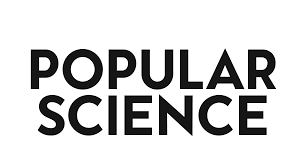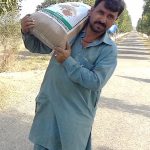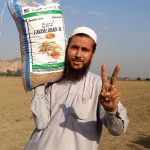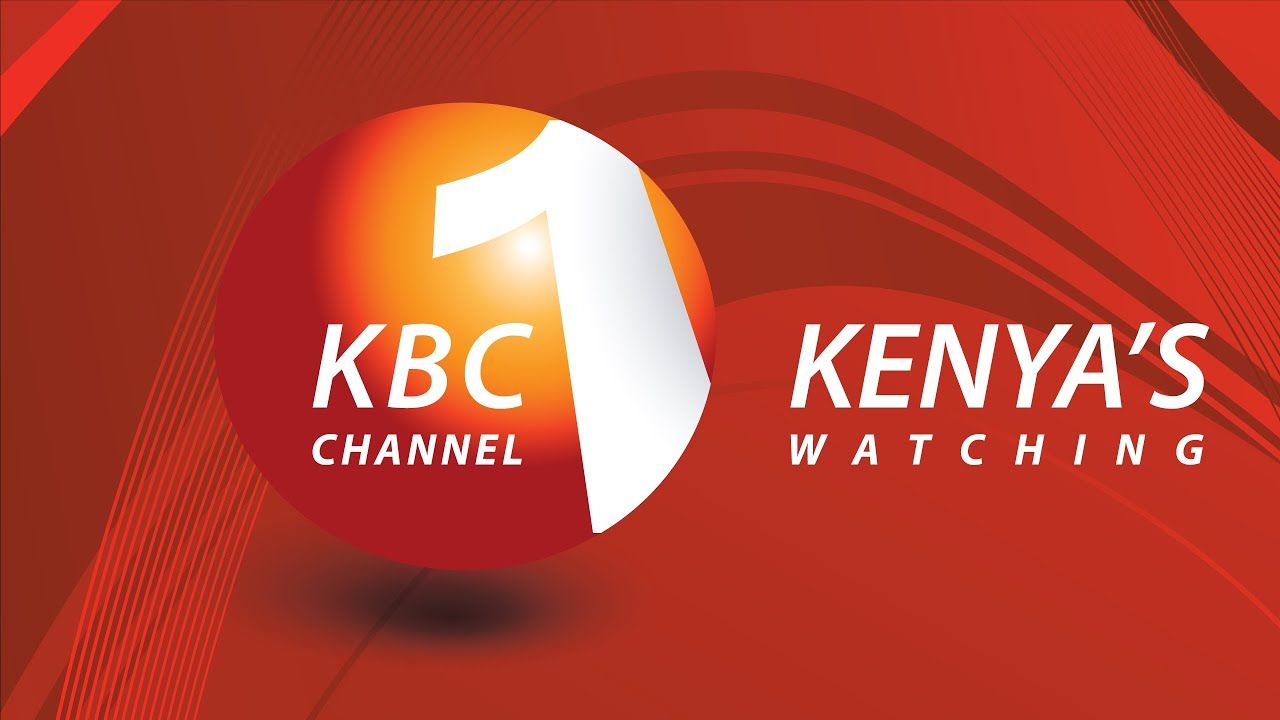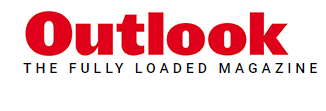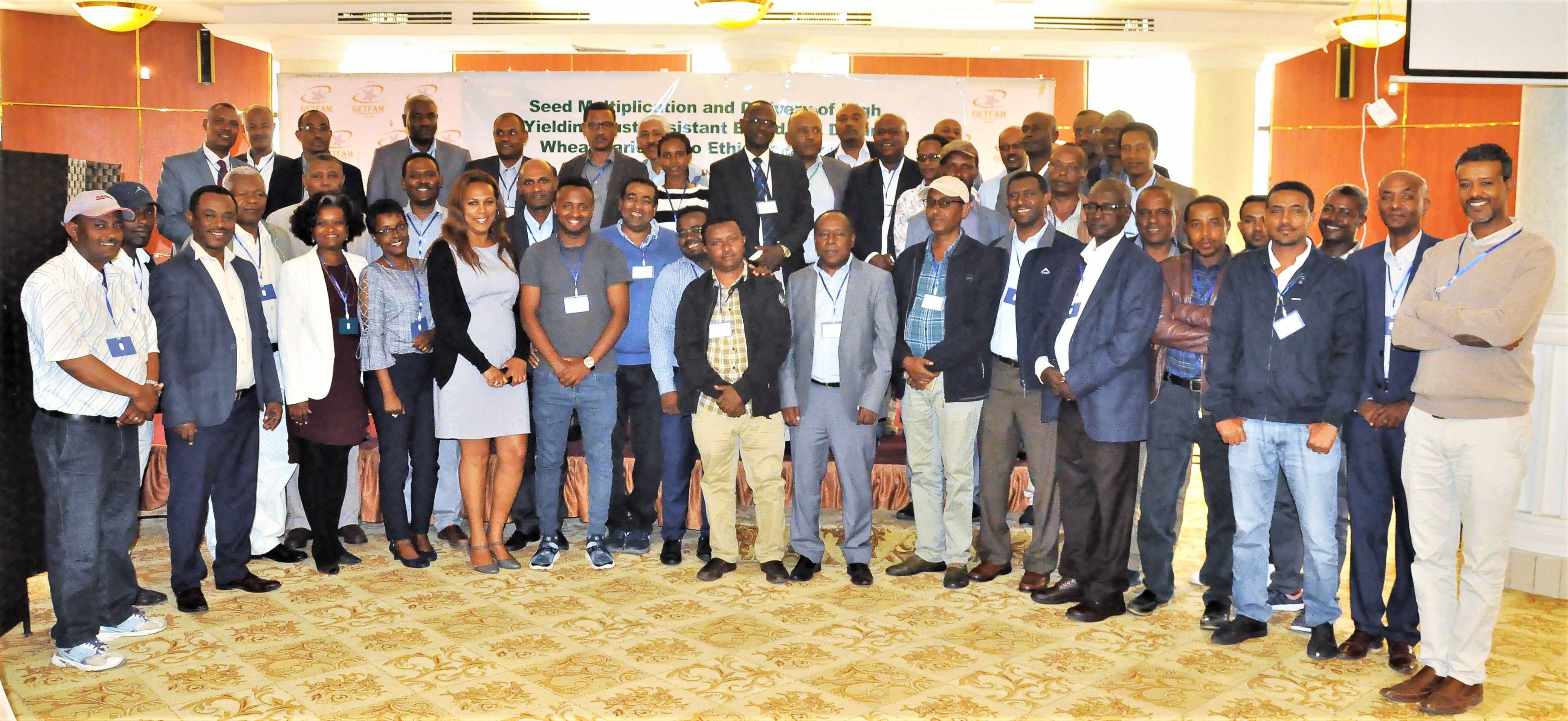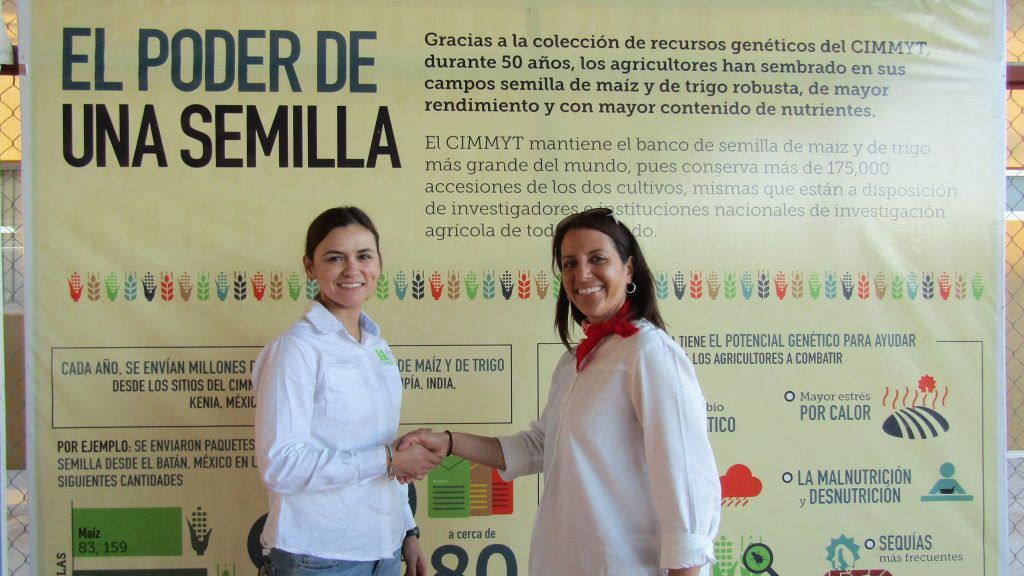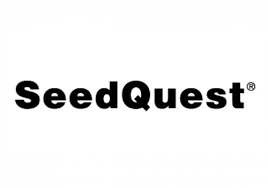Fighting hidden hunger with agricultural innovation
Maize provides 15-16 percent of total calorie intake in Asia, Latin America and sub-Saharan Africa, while wheat provides 18 percent of our total available calories. Hidden hunger occurs when these calories don’t provide the essential micronutrients, such as iron, zinc and vitamin A, needed for healthy growth and prevention of diseases.
On World Health Day, we are sharing five stories showing how the International Maize and Wheat Improvement Center (CIMMYT) is combating hidden hunger and how agricultural research and innovation leads to healthier families, improved livelihoods and a healthier planet.
Climate change impact and adaptation for wheat protein
Often, work on climate change adaptation in agriculture focuses on productivity instead of nutrition of crops. If nutritional implications of climate change are not addressed, there will be devastating consequences on the health and livelihoods of marginalized people who depend on wheat as a source of protein.
A new study examines why wheat grain protein concentration is often overlooked in relation to improving global crop production in the face of climate change challenges and concludes that not all climate change adaptations have positive impacts on human nutrition.
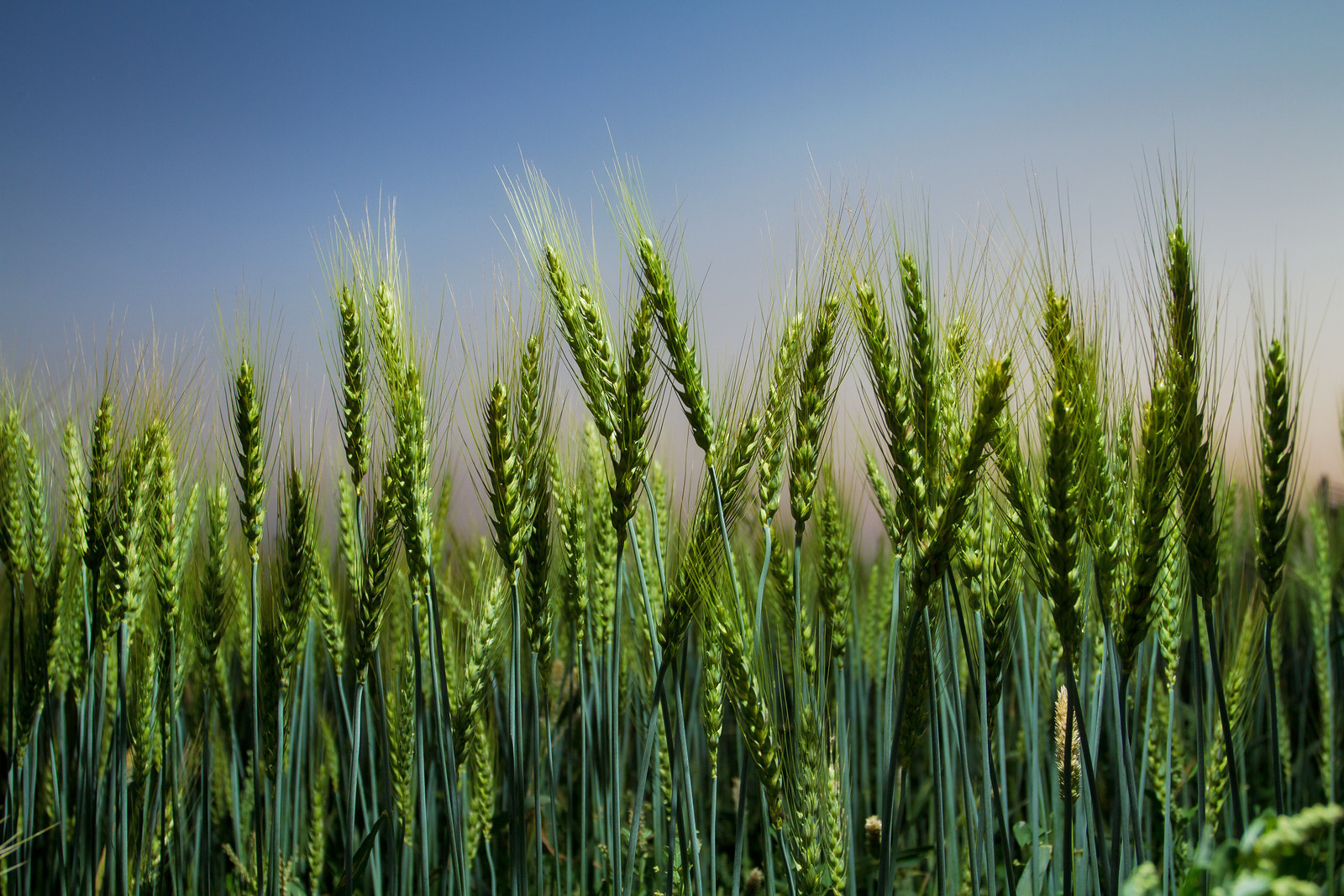
Nutritious vitamin A orange maize boosts health and livelihoods in Zimbabwe
In Zimbabwe, child malnutrition peaked above international thresholds for emergency response. Vitamin A deficiency is the leading cause of preventable blindness in children and can increase risk of measles, diarrhea and respiratory infections. However, biofortification of maize is a sustainable solution to improve health and nutrition in the region.
CIMMYT and Harvest Plus worked together to breed maize with higher amounts of nutritious vitamin A and are working with farmers, seed companies, food processors and millers to make this maize part of the food system in Zimbabwe.
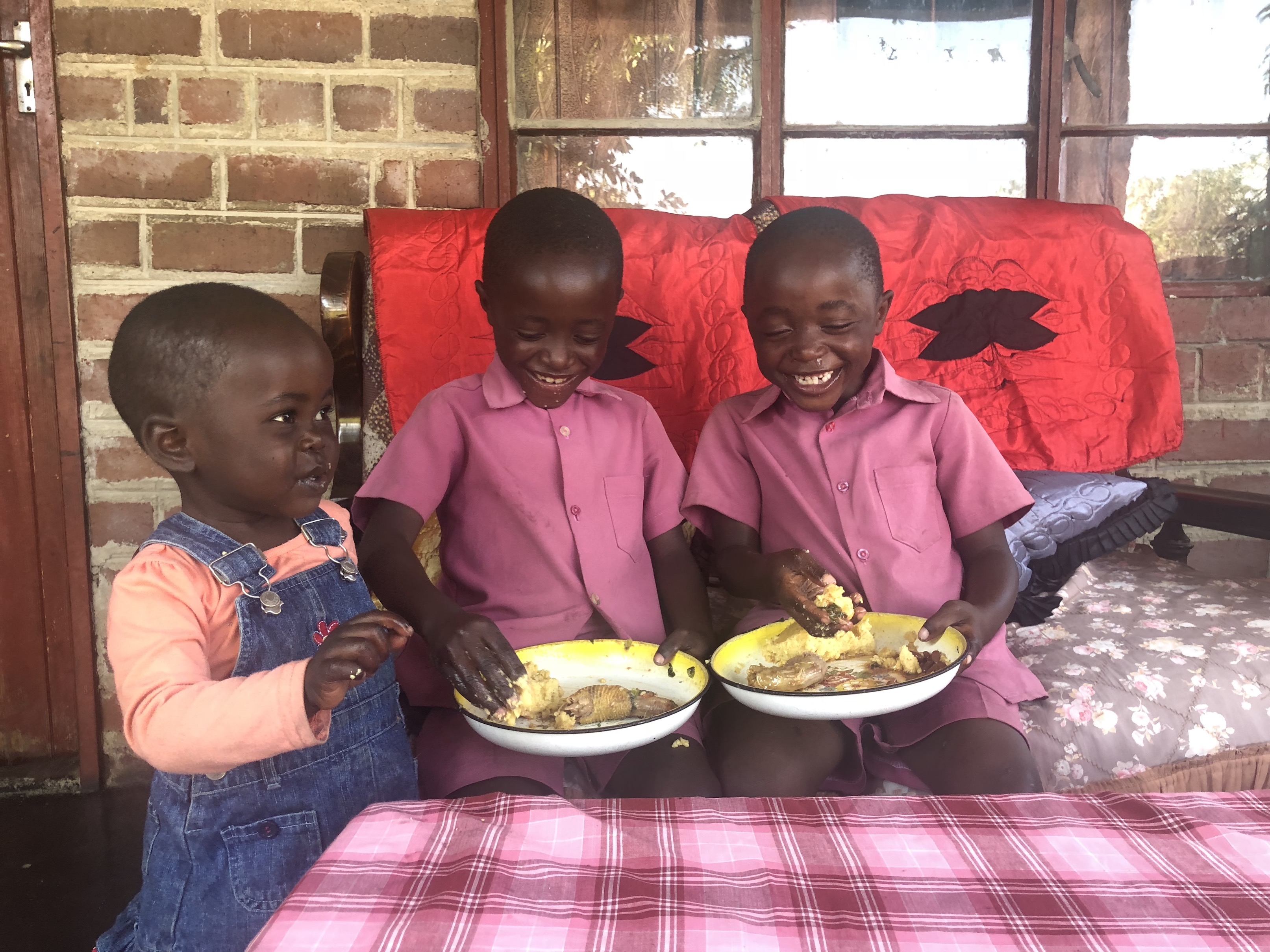
Pakistan wheat seed makeover: More productive, resilient varieties for thousands of farmers
In Pakistan, CIMMYT is working to develop and spread better wheat production systems, by replacing outdated, disease susceptible seeds with new varieties. These new varieties also come with a health benefit — zinc.
According to a 2011 nutrition survey, 39 percent of children in Pakistan and 48 percent of pregnant women suffer from zinc deficiency, leading to child stunting rates of more than 40 percent and high infant mortality. These new seeds will increase the nutrition content of wheat, Pakistan’s number-one food crop, as well as resist diseases such as wheat rust.
Better together: Partnership around zinc maize improves nutrition in Guatemala
Over 46 percent of children under five in Guatemala suffer from chronic malnutrition. More than 40 percent of the country’s rural population is deficient in zinc, an essential micronutrient that plays a crucial role in pre-natal and post-natal development and is key to maintaining a healthy immune system.
CIMMYT, HarvestPlus and Semilla Nueva are working together to change this, through the development and deployment of the world’s first biofortified zinc-enriched maize. Called Fortaleza 3 by Semilla Nueva, it fights against hidden hunger, containing 6-12ppm more zinc and 2.5 times more quality protein compared to conventional maize varieties.
“With the extra income I’ve gotten since switching to F3, I’ve been paying for my daughter to go to school. Fortaleza F3 not only gave me a good harvest, but also the ability to support my daughter’s education,” said Rómulo González, a farmer from the southern coast of Guatemala.
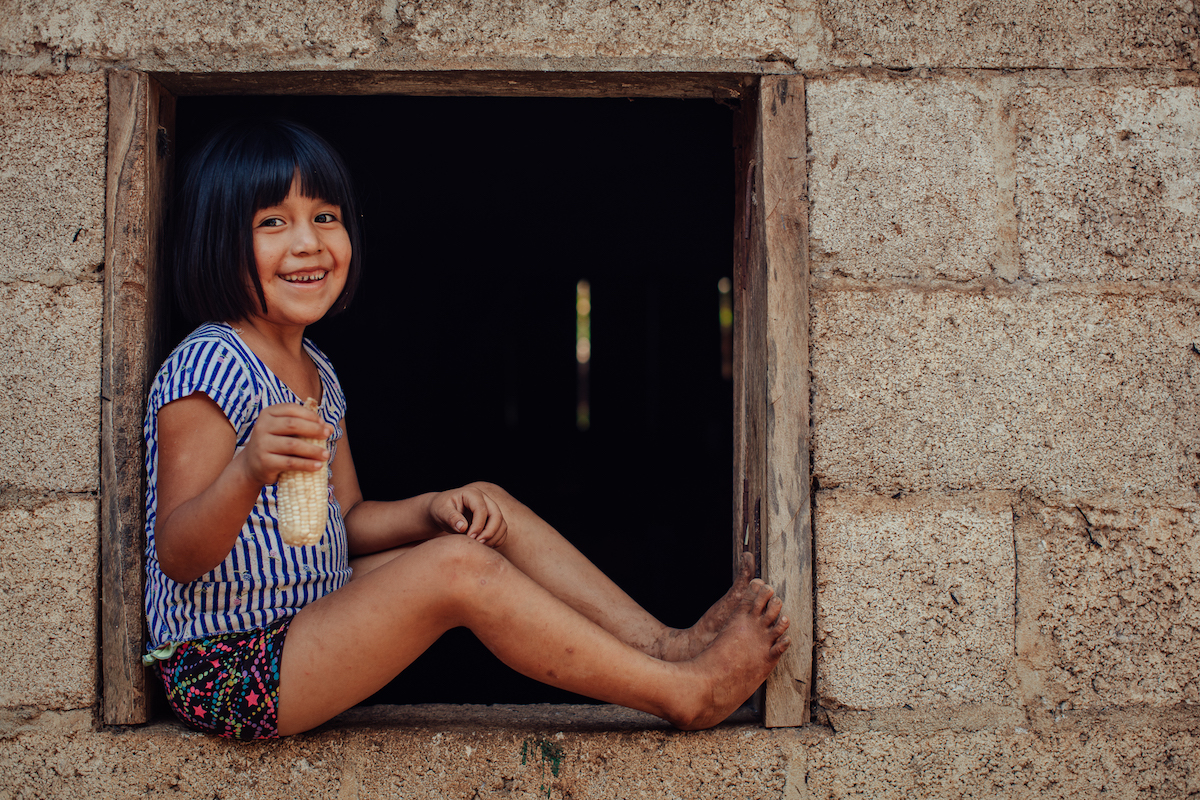
Farmers key to realizing EAT-Lancet report recommendations in Mexico, CIMMYT highlights
The EAT-Lancet Commission Report aims to answer the question: can we feed a future population of 10 billion people a healthy diet within planetary boundaries? It proposes a “planetary health diet” that balances nutrition with sustainable food production.
CIMMYT participated in the report launch in Mexico. “If anybody is able to manage the complex systems that will sustainably yield the volume of nutritious food that the world needs, that’s the farmer,” said Bram Govaerts, Director of Innovative Business Strategies at CIMMYT. “In Mexico, more than 500 thousand farmers already innovate every day and grow maize, wheat and related crops under sustainable intensification practices that CIMMYT and Mexico’s Agriculture Department promote with MasAgro”.
These innovations he mentioned create healthier families and a healthier planet.

How the data revolution could help design better agronomic investments
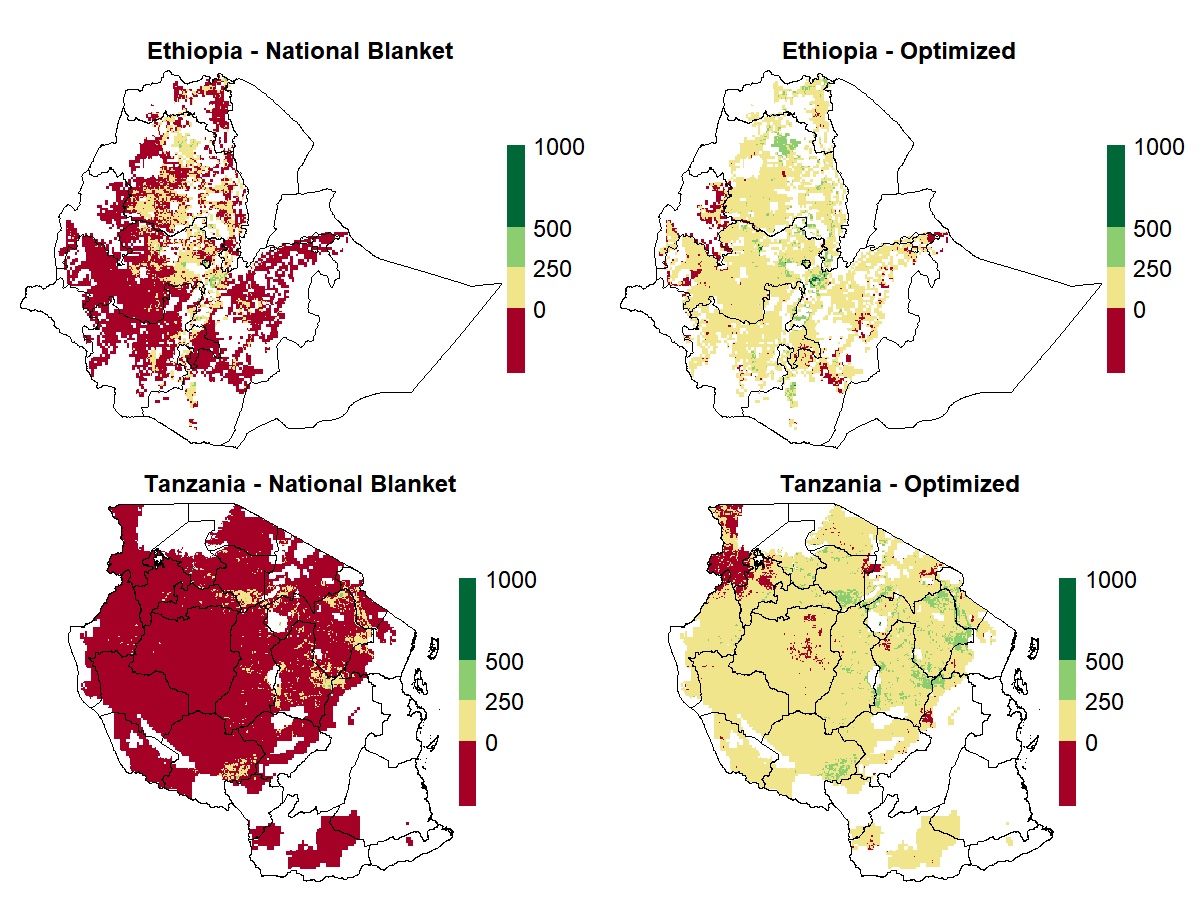
What fertilizer application will give me the best returns? What maize crop variety should I use?
Each farmer faces constraints related to weather uncertainty, soil fertility management challenges, or access to finance and markets. To improve their yields and incomes, African smallholder farmers need agronomic advice adapted to their specific circumstances. The challenge is even greater in sub-Saharan Africa, where agricultural production landscapes are highly diverse. Yet traditional agronomic research was not designed to fit with complex agroecological regions and farming systems. Compounding the problem, research organizations often have limited resources to develop the necessary experiments to generate farm- and site-specific agronomic advice at scale.
“Agronomic research is traditionally not equipped to consider spatial or socio-economic diversity among the millions of farmers it targets,” said Sebastian Palmas, data scientist at the International Maize and Wheat Improvement Center (CIMMYT) in Nairobi, Kenya.
Palmas presented some of the learnings of the Taking Maize Agronomy to Scale in Africa (TAMASA) project during a science seminar called “A spatial ex ante framework for guiding agronomic investments in sub-Saharan Africa” on March, 4, 2019.
The project, funded by the Bill & Melinda Gates Foundation, has used data to improve the way agronomic research for development is done. Researchers working on the TAMASA project addressed this challenge by using available geospatial information and other big data resources, along with new data science tools such as machine learning and Microsoft’s AI for Earth. They were able to produce and package information that can help farmers, research institutions and governments take better decisions on what agronomic practices and investments will give them the best returns.
By adapting the Quantitative Evaluation of the Fertility of Tropical Soils (QUEFTS) model to the conditions of small farmers in TAMASA target countries (Ethiopia, Nigeria and Tanzania), using different layers of information, CIMMYT and its partners have developed a versatile geospatial tool for evaluating crop yield responses to fertilizer applications in different areas of a given country. Because calculations integrate spatial variation of fertilizer and grain prices, the tool evaluates the profitability — a key factor influencing farmers’ fertilizer usage — for each location. The project team can generate maps that show, for instance, the estimated agronomic and economic returns to different fertilizer application scenarios.
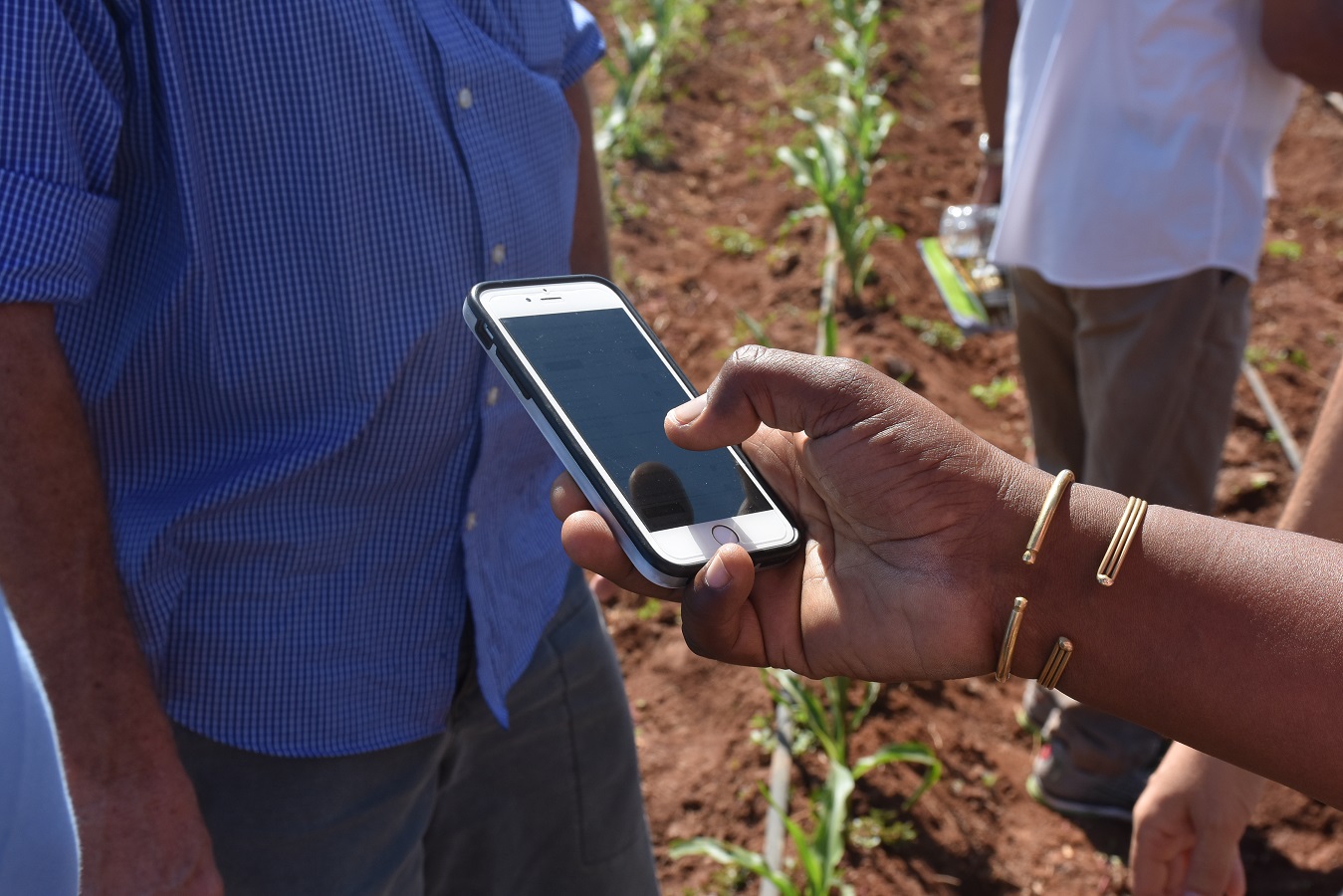
Making profits grow
These tools could potentially help national fertilizer subsidy programs be more targeted and impactful, like the ambitious Ethiopia’s Fertilizer Blending initiative which distributes up to 250,000 tons of fertilizer annually. Initial calculations showed that, by optimizing diammonium phosphate (DAP) and urea application, the profitability per hectare could improve by 14 percent on average, compared to the current fertilizer recommendations.
Such an approach could generate farm-specific advice at scale and boost farmers’ incomes. It could also provide insights on many different issues, like estimating market demand for a new fertilizer blend, or the estimated quantity of additional fertilizer required to bring about a targeted maize yield increase.
Future extensions of the framework may incorporate varietal differences in nutrient management responses, and thus enable seed companies to use the framework to predict where a new maize hybrid would perform best. Similarly, crop breeders could adapt this ex ante assessment tool to weigh the pros and cons of a specific trait and the potential impact for farmers.
The TAMASA team plans to publish the code and user-friendly interface of this new geospatial assessment tool later this year.
Candidate for FAO leadership Qu Dongyu visits CIMMYT’s headquarters to sign MoU and strengthen collaboration
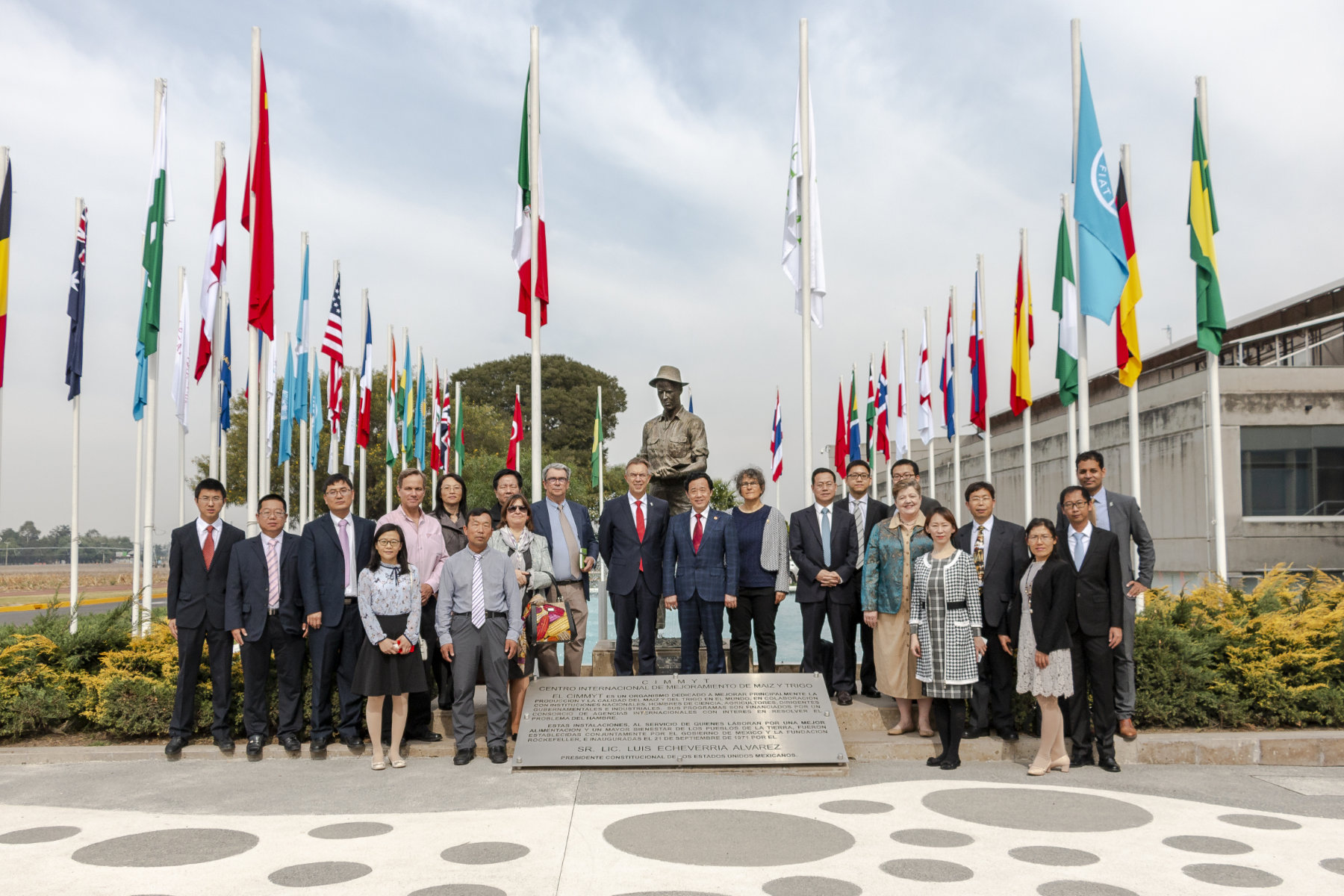
Qu Dongyu, China’s Vice Minister of Agriculture and Rural Affairs, and candidate for the position of Director-General of the Food and Agriculture Organization of the United Nations (FAO), visited the global headquarters of the International Maize and Wheat Improvement Center (CIMMYT) in Mexico on March 16, 2019. He had already visited CIMMYT in 2006.
Vice minister Qu was greeted by students and CIMMYT scientists from China, the director general, the deputy director general and members of the management team. Qu and his delegation learned about CIMMYT’s latest initiatives and toured the campus.
CIMMYT’s director general Martin Kropff explained the organization’s strategic focus on agri-food systems: “Our mandate is on maize and wheat but we think broadly. Our researchers use a systems approach and work on using these two crops to improve peoples’ livelihoods, which is our ultimate goal.”
Qu expressed his career-long efforts for integrating multi-disciplinary approaches to tackle global challenges and said that he was “happy to see CIMMYT combining breeding — for which CIMMYT is famous — with value-added approaches to bring together science, farmers and industry.”
With innovation and the end user playing key roles in the vice minister’s agenda, Qu enjoyed learning about the Excellence in Breeding Platform’s target product profiles work and two-way communication channels from innovation hubs in Mexico.
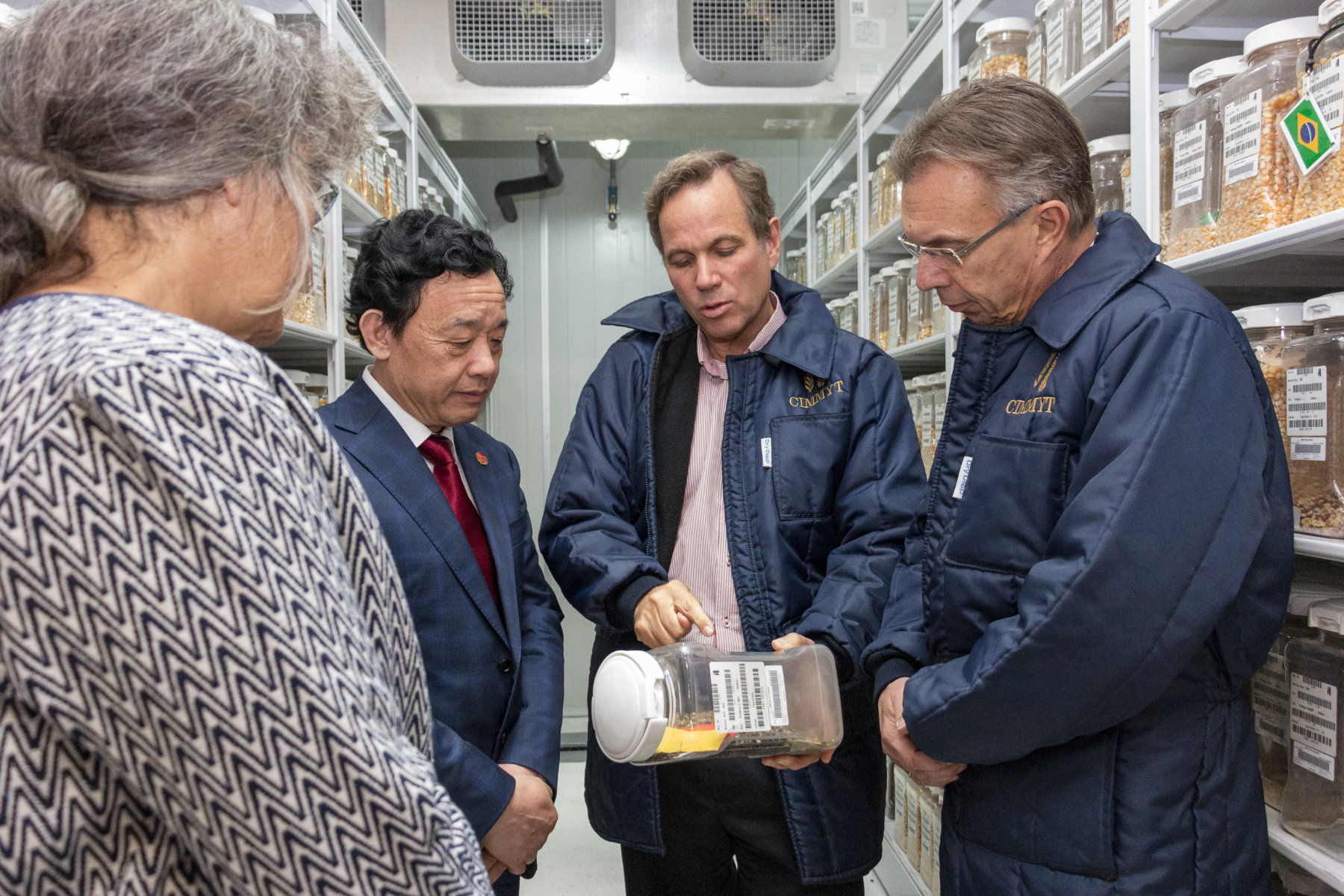
During the visit, Qu was also introduced to CIMMYT’s small-scale machinery, which is used around the world to sustainably intensify production. CIMMYT often sources machines, such as seed planters and harvesters, from China to provide effective and efficient solutions that add tangible value for smallholders at an appropriate price point.
Bringing together advanced technology and inexpensive tools, CIMMYT pioneered the GreenSeeker, a handheld tool to advise farmers on the appropriate amount of nitrogen fertilizer to add to their crops. This tool gives farmers the double benefit of increased profitability and reduced negative environmental impacts. The director of CIMMYT’s Sustainable Intensification program, Bruno Gérard, showed a machine-mountable version of this tool, which could connect to a two-wheel tractor and automatically add the appropriate amount of fertilizer.
Gérard also explained CIMMYT’s efforts to develop mechanization as a service, pointing to the manual on developing mechanization service providers, jointly developed by CIMMYT and FAO: “Mechanization has the potential to improve environmental sustainability, farm productivity and reduce labor drudgery. If mechanization is to be adopted at scale and sustainably, in most cases it has to be provided through service provision to smallholder farmers.”
At the end of the visit, to underline the shared commitment to collaboration that began in the 1970s, Kropff and Qu signed a memorandum of understanding for the establishment of a China-CIMMYT joint laboratory for maize and wheat improvement.
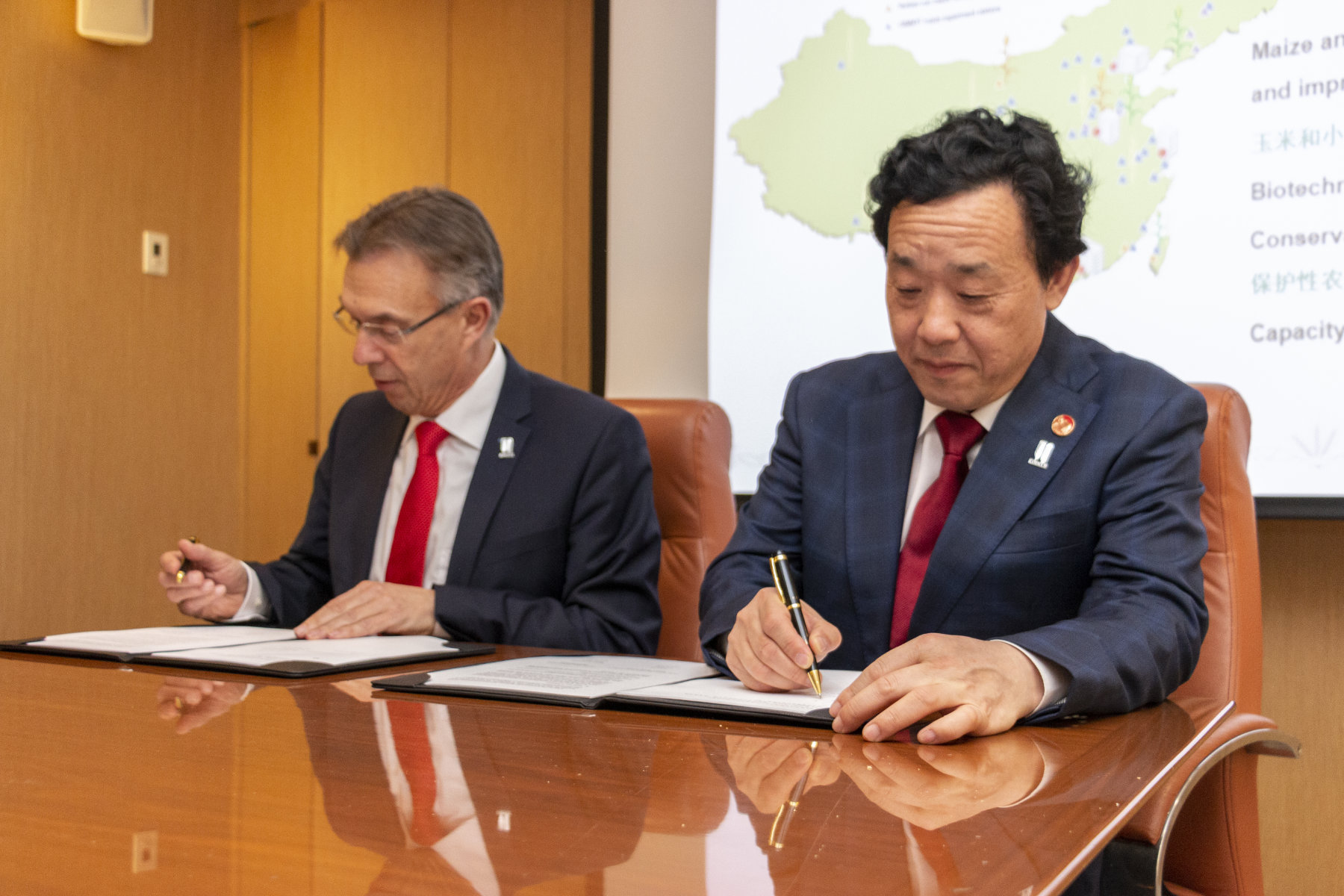
Ethiopia calls for continued collaboration to increase wheat production and meet nutritional and food security

The Ethiopian wheat sector has seen progress since the early 2000s, more than doubling the average farm yields from 1.13 tons per hectare in 1998/99 to 2.74 tons per hectare in 2017/18. Progressive farmers who plant improved wheat varieties and follow recommended agronomic practices could harvest four to six tons per hectare in high-potential wheat growing areas. However, the production is not keeping up with the growing wheat demand: imports reached over 1.5 million tons last year. The Ethiopian government has announced recently that the country should become wheat self-sufficient over the next four years.
One of the biggest wheat production challenges in Ethiopia has been the stem rust and yellow rust diseases caused by Pucccinia spp, which severely affected popular wheat varieties like Kubsa, Galema and Digalu that wiped out from production.
In response to these losses, the International Maize and Wheat Improvement Center (CIMMYT) started an emergency project to multiply and disseminate rust-resistant wheat varieties in the affected regions in 2014, with support from USAID.
The following year, CIMMYT launched the Seed Multiplication and Delivery of High Yielding Rust Resistant Bread and Durum Wheat Varieties to Ethiopian Farmers project. It benefitted people in 54 woredas (districts) of 4 regions: Amhara, Oromia, SNNP and Tigray. CIMMYT collaborated with the Ethiopian Institute of Agricultural Research (EIAR), regional agricultural research institutes and the regional bureaus of agriculture.
This wheat seed scaling project wrapped up with a closure workshop on March 7, 2019. Organized by CIMMYT and EIAR, it gathered representatives from USAID, policymakers, researchers and other governmental and non-governmental institutions.

State minister of agriculture Aynalem Nigussie noted that the project boosted farmers’ productivity thanks to better seeds, improved farming practices and increased knowledge to deal with wheat rust diseases. She recognized that the project aligned with national priorities, as the government is devising a new seed policy to address the current challenges of the Ethiopian wheat seed sector.
CIMMYT’s representative in Ethiopia, Bekele Abeyo, highlighted some of the project outcomes. Some of the achievements in the past four years included the release and demonstration of 23 wheat varieties — 18 bread and 5 durum types —, increased access to these improved seeds for 131,132 households and production of 39,750 tons of wheat grain. Extension agents from 54 woredas participated in training in wheat rust management, recommended agronomic packages for the new wheat varieties, and field data collection and management.
Lessons learned
Abeyo explained that the project could reach a high number of farmers thanks to effective teamwork between the various stakeholders, seed support on revolving bases and a decentralized seed production to reach even remote places. Clustering farmers’ plots favored quality seed production.
Participants flagged weak market linkages, particularly for farmers producing durum wheat, , as a bottleneck to address. Workshop participants recommended the establishment of a wheat task force involving the private sector and with continuous support from funders like USAID.
The director general of EIAR, Mandefro Nigusse, said that the issues raised are inputs for further actions, and some will have to be directed to researchers and breeders to come up with additional solutions for the challenges the wheat sector is facing.
Eyasu Abrha, Advisor to the Minister of Agriculture, officially closed the workshop. He noted that the government of Ethiopia is putting effort into ensuring nutritional and food security, and that projects such as this one are important to address critical challenges in the sector. Abrha acknowledged the support of CIMMYT, EIAR and USAID, and called for a continued collaboration with the government of Ethiopia to meet nutritional and food security goals.
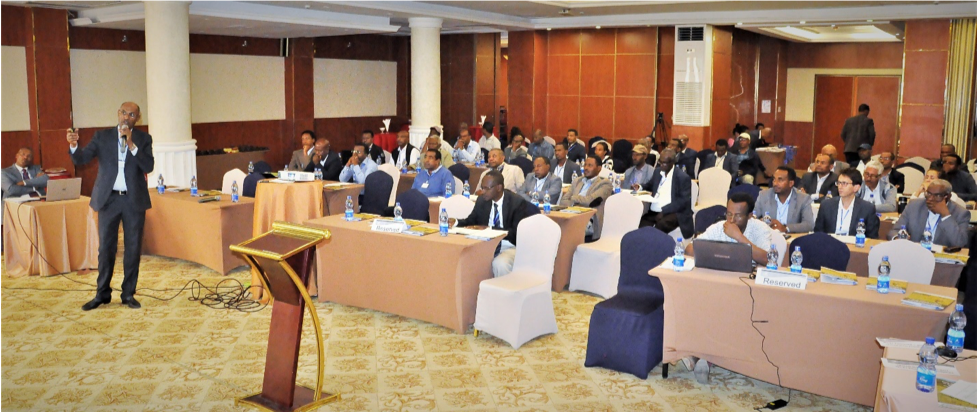
Q&A with 2019 Women in Triticum awardee Carolina Rivera
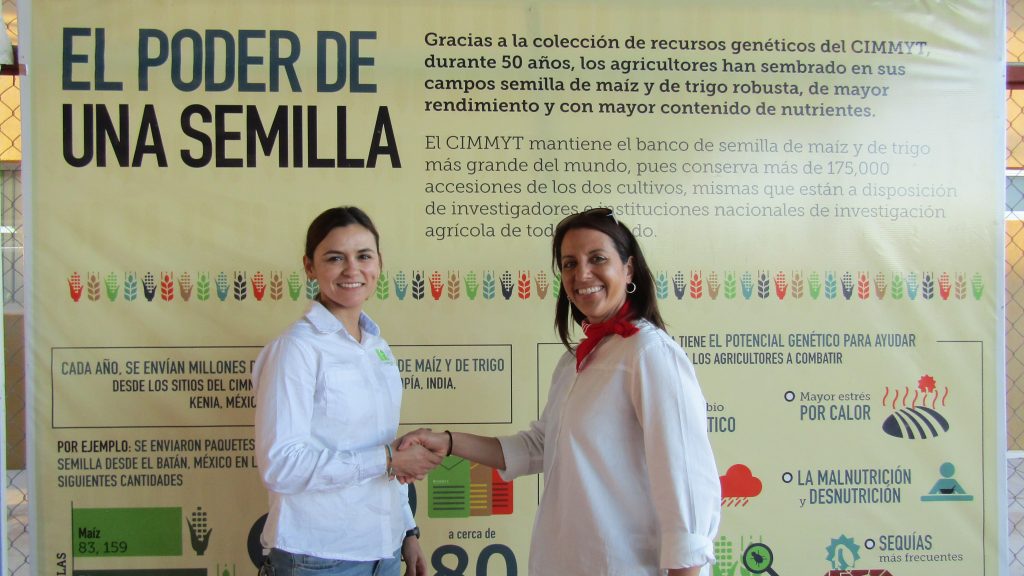
As a native of Obregon, Mexico, Carolina Rivera has a unique connection to the heart of Norman Borlaug’s wheat fields. She is now carrying on Borlaug’s legacy and working with wheat as a wheat physiologist at the International Maize and Wheat Improvement Center (CIMMYT) and data coordinator with the International Wheat Yield Partnership (IWYP).
Given her talents and passion for wheat research, it is no surprise that Rivera is one of the six recipients of the 2019 Jeanie Borlaug Laube Women in Triticum (WIT) Early Career Award. As a young scientist at CIMMYT, she has already worked to identify new traits associated with the optimization of plant morphology aiming to boost grain number and yield.
The Jeanie Borlaug Laube WIT Award provides professional development opportunities for women working in wheat. The review panel responsible for the selection of the candidates at the Borlaug Global Rust Initiative (BGRI), was impressed by her commitment towards wheat research on an international level and her potential to mentor future women scientists.
Established in 2010, the award is named after Jeanie Borlaug Laube, wheat science advocate and mentor, and daughter of Nobel Laureate Dr. Norman E. Borlaug. As a winner, Rivera is invited to attend a training course at CIMMYT in Obregon, Mexico, in spring 2020 as well as the BGRI 2020 Technical Workshop, to be held in the UK in June 2020. Since the award’s founding, there are now 50 WIT award winners.
The 2019 winners were announced on March 20 during CIMMYT’s Global Wheat Program Visitors’ Week in Obregon.
In the following interview, Rivera shares her thoughts about the relevance of the award and her career as a woman in wheat science.
Q: What does receiving the Jeanie Borlaug Laube WIT Award mean to you?
I feel very honored that I was considered for the WIT award, especially after having read the inspiring biographies of former WIT awardees. Receiving this award has encouraged me even more to continue doing what I love while standing strong as a woman in science.
It will is a great honor to receive the award named for Jeanie Borlaug, who is a very active advocate for wheat research. I am also very excited to attend the BGRI Technical Workshop next year, where lead breeders and scientists will update the global wheat community on wheat rust research. I expect to see a good amount of women at the meeting!
Q: When did you first become interested in agriculture?
My first real encounter with agriculture was in 2009 when I joined CIMMYT Obregon as an undergraduate student intern. I am originally from Obregon, so I remember knowing about the presence of CIMMYT, Campo Experimental Norman E. Borlaug (CENEB) and Instituto Nacional de Investigación Forestales Agrícolas y Pecuario (Inifap) in my city but not really understanding the real importance and impact of the research coming from those institutions. After a few months working at CIMMYT, I became very engrossed in my work and visualized myself as a wheat scientist.
Q: Why is it important to you that there is a strong community of women in agriculture?
We know women play a very important role in agriculture in rural communities, but in most cases they do not get the same rights and recognition as men. Therefore, policies — such as land rights — need to be changed and both women and men need to be educated in gender equity. I think the latter factor is more likely to strengthen communities of women, both new and existing, working in agriculture.
In addition, women should participate more in science to show that agricultural research is an area where various ideas and perspectives are necessary. To achieve this in the long run, policies need to look at current social and cultural practices holding back the advancement of women in their careers.
Q: What are you currently working on with CIMMYT and IWYP?
I am a post-doctoral fellow in CIMMYT’s Global Wheat Program where I assist in collaborative projects to improve wheat yield potential funded by IWYP. I am also leading the implementation of IWYP’s international research database, helping to develop CIMMYT’s wheat databases in collaboration with the center’s Genetic Resources Program. Apart from research and data management, I am passionate about offering trainings to students and visitors on field phenotyping approaches.
Q: Where do you see yourself in the agriculture world in 10 years?
In 10 years, I see myself as an independent scientist, generating ideas that contribute to delivering wheat varieties with higher yield potential and better tolerance to heat and drought stresses. I also see myself establishing strategies to streamline capacity building for graduate students in Mexico. At that point, I would also like to be contributing to policy changes in education and funding for science in Mexico.
Innovative irrigation promises “more crop per drop” for India’s water-stressed cereals
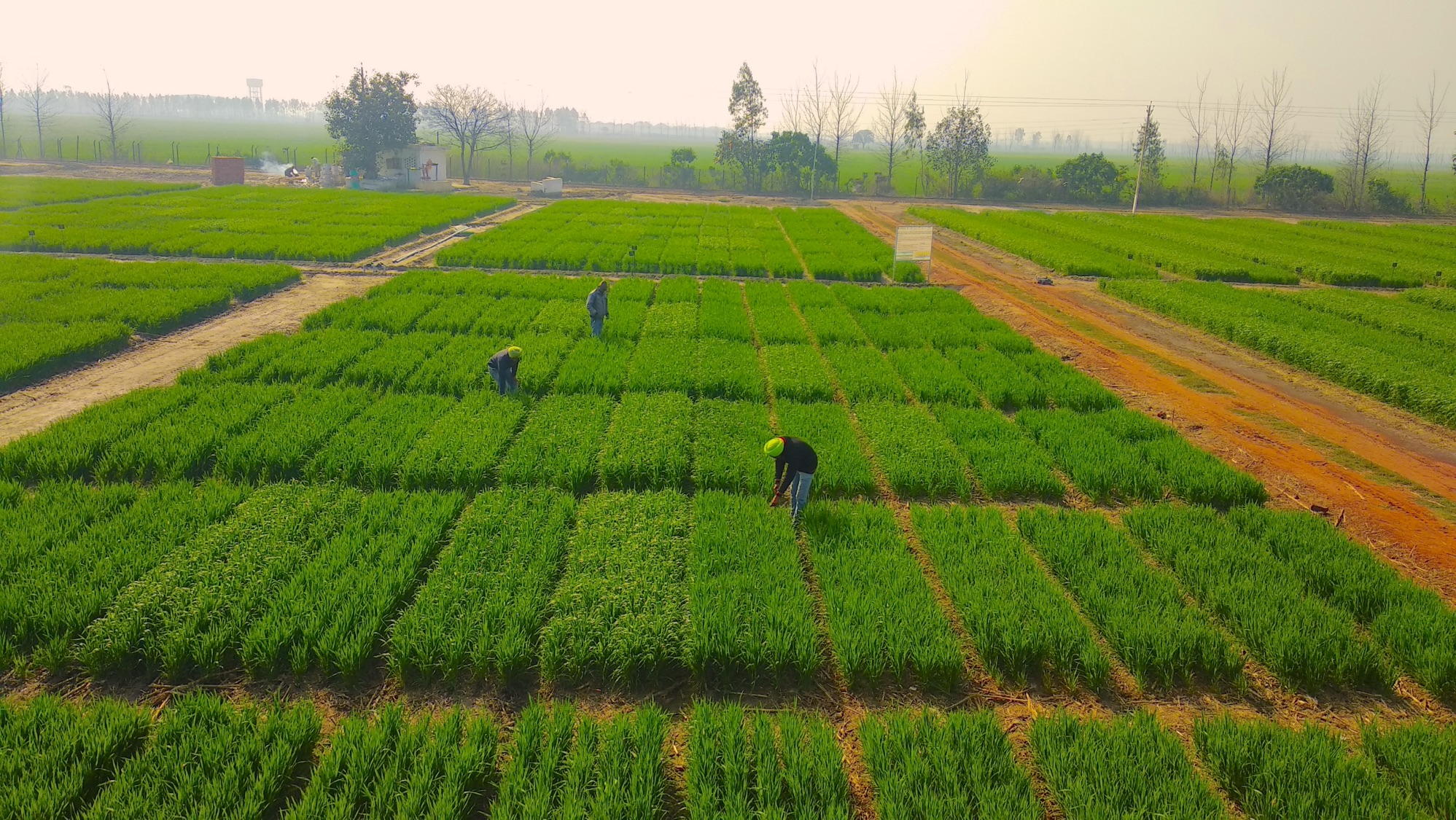
On World Water day, researchers show how India’s farmers can beat water shortages and grow rice and wheat with 40 percent less water
India’s northwest region is the most important production area for two staple cereals: rice and wheat. But a growing population and demand for food, inefficient flood-based irrigation, and climate change are putting enormous stress on the region’s groundwater supplies. Science has now confronted this challenge: a “breakthrough” study demonstrates how rice and wheat can be grown using 40 percent less water, through an innovative combination of existing irrigation and cropping techniques. The study’s authors, from the International Maize and Wheat Improvement Center (CIMMYT), the Borlaug Institute for South Asia (BISA), Punjab Agricultural University and Thapar University, claim farmers can grow similar or better yields than conventional growing methods, and still make a profit.
The researchers tested a range of existing solutions to determine the optimal mix of approaches that will help farmers save water and money. They found that rice and wheat grown using a “sub-surface drip fertigation system” combined with conservation agriculture approaches used at least 40 percent less water and needed 20 percent less Nitrogen-based fertilizer, for the same amount of yields under flood irrigation, and still be cost-effective for farmers. Sub-surface drip fertigation systems involve belowground pipes that deliver precise doses of water and fertilizer directly to the plant’s root zone, avoiding evaporation from the soil. The proposed system can work for both rice and wheat crops without the need to adjust pipes between rotations, saving money and labor. But a transition to more efficient approaches will require new policies and incentives, say the authors.
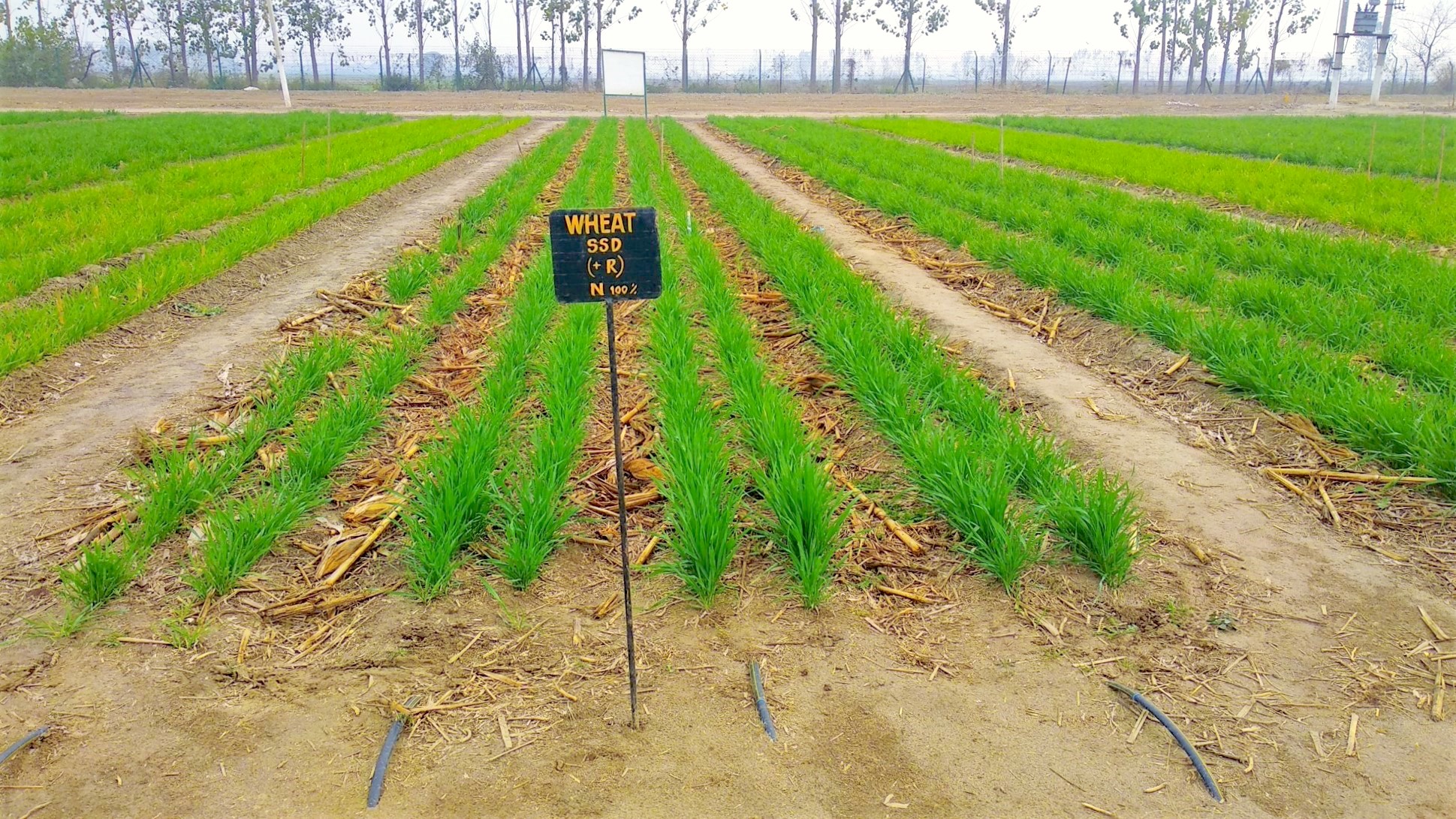
Read the full story:
Innovative irrigation system could future-proof India’s major cereals. Thomsom Reuters Foundation News, 20 March 2019.
Read the study:
Sidhu HS, Jat ML, Singh Y, Sidhu RK, Gupta N, Singh P, Singh P, Jat HS, Gerard B. 2019. Sub-surface drip fertigation with conservation agriculture in a rice-wheat system: A breakthrough for addressing water and nitrogen use efficiency. Agricultural Water Management. 216:1 (273-283). https://doi.org/10.1016/j.agwat.2019.02.019
The study received funding from the CGIAR Research Program on Wheat (WHEAT), the Indian Council of Agricultural Research (ICAR) and the Government of Punjab. The authors acknowledge the contributions of the field staff at BISA and CIMMYT based at Ludhiana, Punjab state.
CIMMYT and UAS-Bangalore to establish a maize doubled haploid facility in Karnataka, India
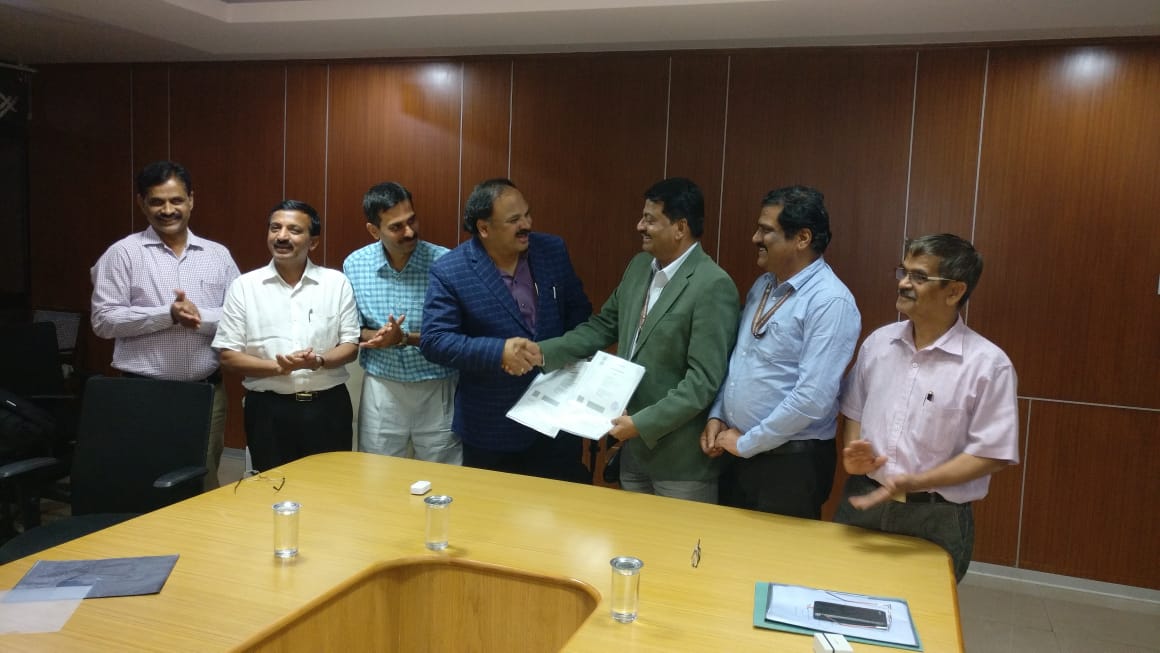
KARNAKATA, India (CIMMYT) — The International Maize and Wheat Improvement Center (CIMMYT) and the University of Agricultural Sciences-Bangalore (UAS-Bangalore) have signed a collaboration agreement for establishing a maize doubled haploid (DH) facility at the Agricultural Research Station in Kunigal (ARS-Kunigal), Tumkur district, Karnataka state, India.
CIMMYT will establish and operate the maize DH facility, including field activities and the associated laboratory. Occupying 12 acres of land, the facility is estimated to produce at least 30,000 DH lines a year. CIMMYT hopes the facility to be operational by the last quarter of 2019.
The maize DH facility, funded by the CGIAR Research Program on Maize (MAIZE), fulfills a very important requirement of the region. It has the potential to accelerate maize breeding and hybrid development and significantly increase genetic gains through maize breeding in Asia. During the 13th Asian Maize Conference in Ludhiana, India (October 8-10, 2018), several partners — including the Indian Institute of Maize Research (ICAR-IIMR) — emphasized the urgent need for a state-of-the-art maize DH facility that could serve breeding programs across Asia.
“This is indeed a major landmark for maize breeding, especially in the public sector, not only in India, but also in Asia,” said B.M. Prasanna, Director of CIMMYT’s Global Maize Program and the CGIAR Research Program on Maize (MAIZE). “The facility will provide maize DH development services, not only for the maize breeding programs of CIMMYT and UAS-B, but also for national agricultural research system institutions and small and medium-sized seed companies engaged in maize breeding and interested to pursue DH-based advanced maize breeding strategies in Asia. DH technology, in combination with molecular marker-assisted breeding, can significantly increase genetic gains in maize breeding.”
“The maize doubled haploid facility … will be the first of its kind in the public domain in Asia,” said S. Rajendra Prasad, Vice Chancellor of UAS-Bangalore. “The work done at this facility will certainly benefit the farmers of the state, country and the Asian region, by accelerating maize breeding and improving efficiencies.”
The signing of the collaboration agreement took place on February 18, 2019 at UAS-Bangalore’s campus in Bengaluru. CIMMYT was represented by B.M. Prasanna and BS Vivek, Senior Maize Breeder. UAS-Bangalore was represented by S. Rajendra Prasad; Mahabaleshwar Hegde, Registrar, and Y.G. Shadakshari, Director of Research.
The benefits of doubled haploid technology
DH maize lines are highly uniform, genetically pure and stable, and enable significant saving of time and resources in deriving parental lines, which are building blocks of improved maize hybrids.
Over the last 12 years, CIMMYT has worked intensively on optimizing DH technology for the tropics. Researchers released first-generation tropicalized haploid inducers in 2012, and second-generation tropicalized haploid inducers in 2017, in partnership with the University of Hohenheim, Germany. In 2017, CIMMYT developed more than 93,000 maize DH lines from 455 populations, and delivered them to maize breeders in Africa, Asia and Latin America.
INTERVIEW OPPORTUNITIES:
B.M. Prasanna – Director of CIMMYT’s Global Maize Program and the CGIAR Research Program on Maize (MAIZE).
FOR MORE INFORMATION, CONTACT THE MEDIA TEAM:
Jennifer Johnson – Maize Communication Officer, CIMMYT. J.A.JOHNSON@cgiar.org, +52 (55) 5804 2004 ext. 1036.
New publications: Biofortification of maize with provitamin A can reduce aflatoxin load
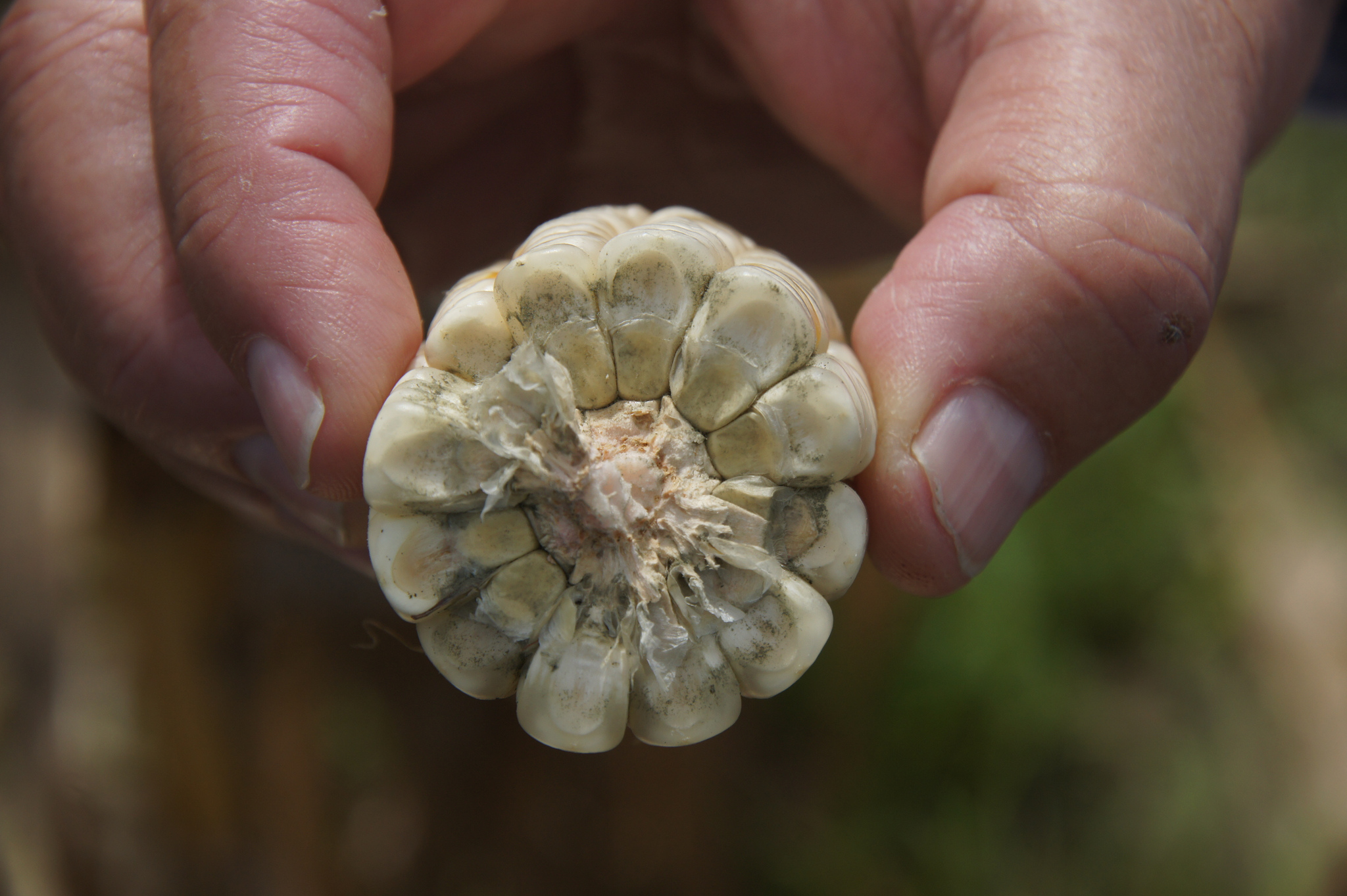
New research evidence could have significant implications for breeding approaches to combat harmful aflatoxin contamination in maize while simultaneously contributing to alleviate vitamin A deficiency. The study “Provitamin A Carotenoids in Grain Reduce Aflatoxin Contamination of Maize While Combating Vitamin A Deficiency” is the first published report to document how biofortification with provitamin A can contribute to reduce aflatoxin contamination in maize.
Aflatoxins are harmful compounds that are produced by the fungus Aspergillus flavus, which can be found in the soil, plants and grain of a variety of legumes and cereals including maize. Toxic to humans and animals, aflatoxins are associated with liver and other types of cancer, as well as with weakened immune systems that result in increased burden of disease, micronutrient deficiencies, and stunting or underweight development in children.
Efforts to breed maize varieties with resistance to aflatoxin contamination have proven difficult and elusive. Contamination of maize grain and products with aflatoxin is especially prevalent in low- and middle-income countries where monitoring and safety standards are inconsistently implemented.
Biofortification also serves to address “hidden hunger,” or micronutrient deficiency. Over two billion people are affected globally — they consume a sufficient amount of calories but lack essential micronutrients such as vitamins and minerals. Vitamin A deficiency specifically compromises the health of millions of maize consumers around the world, including large parts of sub-Saharan Africa.
Provitamin A-enriched maize is developed by increasing the concentration of carotenoids — the precursors of vitamin A — and powerful antioxidants that play important roles in reducing the production of aflatoxin by the fungus Aspergillus flavus. The relative ease of breeding for increased concentrations of carotenoids as compared to breeding for aflatoxin resistance in maize make this finding especially significant as part of a solution to aflatoxin contamination problems.
Breeding of provitamin A-enriched maize varieties is ongoing at the International Maize and Wheat Improvement Center (CIMMYT) and the International Institute of Tropical Agriculture (IITA), with the support of HarvestPlus. Several varieties trialed in sub-Saharan Africa have demonstrated their potential to benefit vitamin-deficient maize consumers.
The researchers highlight the potential in breeding maize with enhanced levels of carotenoids to yield the dual health benefits of reduced aflatoxin concentration in maize and reduced rates of vitamin A deficiency. This result is especially significant for countries where the health burdens of exposure to aflatoxin and prevalence of vitamin A deficiency converge with high rates of maize consumption.
Read the full study here: https://www.frontiersin.org/articles/10.3389/fpls.2019.00030/full
Financial support for this study was partially provided by HarvestPlus, a global alliance of agriculture and nutrition research institutions working to increase the micronutrient density of staple food crops through biofortification. The views expressed do not necessarily reflect those of HarvestPlus. The CGIAR Research Program on Maize (MAIZE) also supported this research.
This research builds on the Ph.D. dissertation of Dr. Pattama Hannok at University of Wisconsin, Madison, WI, United States (Hannok, 2015).
